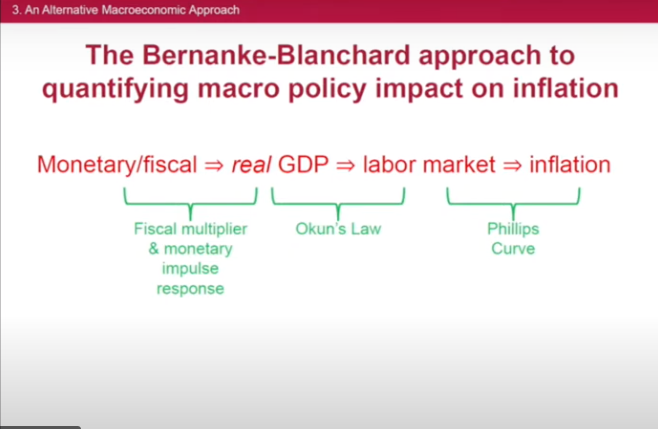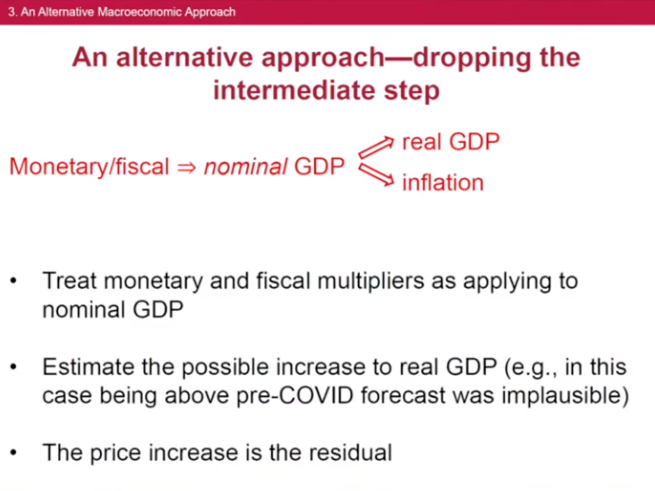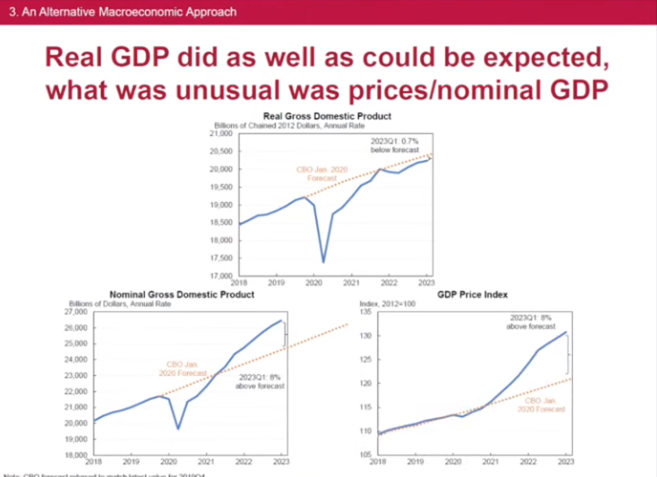[ad_1]
David Beckworth directed me to an fascinating debate at a current Brookings panel. Olivier Blanchard and Ben Bernanke introduced a paper that evaluated varied elements within the current inflation surge, highlighting the function of provide points associated to meals, power, shortages, and many others. To be clear, they famous that among the provide bottlenecks occurred as a consequence of earlier over-stimulus of demand. In addition they argued (accurately in my opinion) that inflation strikes from transitory to everlasting when it turns into embedded extreme wage development. The preliminary inflation surge was excessive costs relative to wages; the present downside is extreme wage development.
In his dialogue, Jason Furman introduced a slide exhibiting his interpretation of their framework for combination demand shocks:

He contrasted that along with his most well-liked framework for the evaluation:

Very long time readers will acknowledge that that is additionally my most well-liked mind-set about demand shocks. By itself, actual GDP tells us nearly nothing about demand. In distinction, NGDP is an inexpensive proxy for combination demand. (That doesn’t cease pundits from often citing actual output and/or actual consumption information as “demand,” though that’s an EC101-level error.)
Within the subsequent dialogue, Bernanke objected that the implications of rising NGDP have been ambiguous, as one might think about a state of affairs the place each the AS and AD curve shifted upward (much less AS, extra AD, no change in output.) Thus secure RGDP and rising NGDP doesn’t essentially suggest that the issue is primarily extra demand. He might have been reacting to this slide from Furman:

In an accounting sense, it seems just like the inflation downside is 100% nominal, with actual GDP roughly on development. If I’m not mistaken, Bernanke’s argument is that in a counterfactual the place NGDP rose much less strongly, it’s potential that output would have been decrease (as a consequence of COVID, Ukraine, and many others.) and we nonetheless would have skilled some extra inflation (albeit presumably lower than what we really skilled.)
Right here’s why I desire Furman’s method: Previous to COVID, unemployment was roughly 3.5%, and therefore the financial system was most likely near equilibrium. In that case, we must always not have been aiming for quick NGDP development to cut back unemployment under 2019 ranges. Slightly, we must always have aimed for NGDP development of roughly 2% plus the Fed’s estimate of development RGDP development after 2019. Actually, we bought a pair trillion {dollars} in extra NGDP development, roughly 8% above development. It will be stunning if that kind of fast development in nominal spending had not created excessive inflation, provided that we have been already close to full employment in early 2020.
That doesn’t imply that Bernanke’s theoretical remark is wrong. Slightly, I’m suggesting that his level might be of restricted relevance for this explicit episode. Maybe COVID lowered combination provide by 1% or 2% between early 2020 and at the moment, and the highly effective demand stimulus boosted output by a roughly equal quantity, leaving RGDP near development. If NGDP had grown at development, maybe output could be 1% or 2% decrease than present ranges.
What appears implausible is that the change in combination provide over the previous three years is something near the 8% overshoot of demand. That kind of fast development in nominal spending will not be a crucial situation for inflation (provide shocks can even enhance the CPI), however it appears to me that it’s fairly near a enough situation for top inflation within the absence of some kind of really extraordinary enhance in combination provide.
So whereas Bernanke is true that quick rising NGDP doesn’t definitively show that extra demand is the reason for the current inflation overshoot, given believable estimates of shifts within the AS curve, it appears extremely doubtless that the 8% NGDP overshoot is by far crucial reason behind excessive inflation.
Furman additionally made some excellent observations in regards to the difficulties concerned in separating provide and demand shocks. For example, congestion on the ports looks like a “provide downside.” However most of this congestion was not attributable to a bodily downside on the ports. In response to Furman, import volumes at US ports have been far greater in 2021 than in 2019. As a substitute, it was the terribly giant demand for items throughout 2021 (partly pushed by stimulus checks) that was inflicting congestion on the ports. So in a way even the “bottleneck” issues have been partly extra demand, though they seemed like a provide downside. (Once more, Blanchard and Bernanke acknowledged this downside of their paper.)
In EC101, we’re taught that P and Y, thought-about in isolation, inform us nothing about provide and demand shocks. NGDP is completely different. It measures costs occasions output, or complete nominal expenditure. Thus NGDP is a reasonably direct learn on combination demand. As a substitute of all kinds of sectors (meals, power, providers, labor, funding, durables, exports, and many others.), NGDP offers a easy and stylish mind-set about complete demand within the financial system.
Sure, the Fed doesn’t straight goal NGDP. However there is no such thing as a believable interpretation of the Fed’s twin mandate the place—if ranging from equilibrium—it’s acceptable to have NGDP development both far above 4% or far under 4%. In 2008-09, we went roughly 8% under development (which was then 5%), and prior to now three years we’ve gone roughly 8% above. When the deviations in NGDP are that enormous, it’s cheap to say that the issue is primarily demand.
P.S. After all, I favor NGDP concentrating on, which is another excuse to desire Furman’s framing of the difficulty. However I’d desire his method even when the Fed sticks to its present “twin mandate” method. As St. Louis Fed President Jim Bullard as soon as noticed, the implications of FAIT (if symmetrical) are fairly just like NGDP degree concentrating on.
[ad_2]

